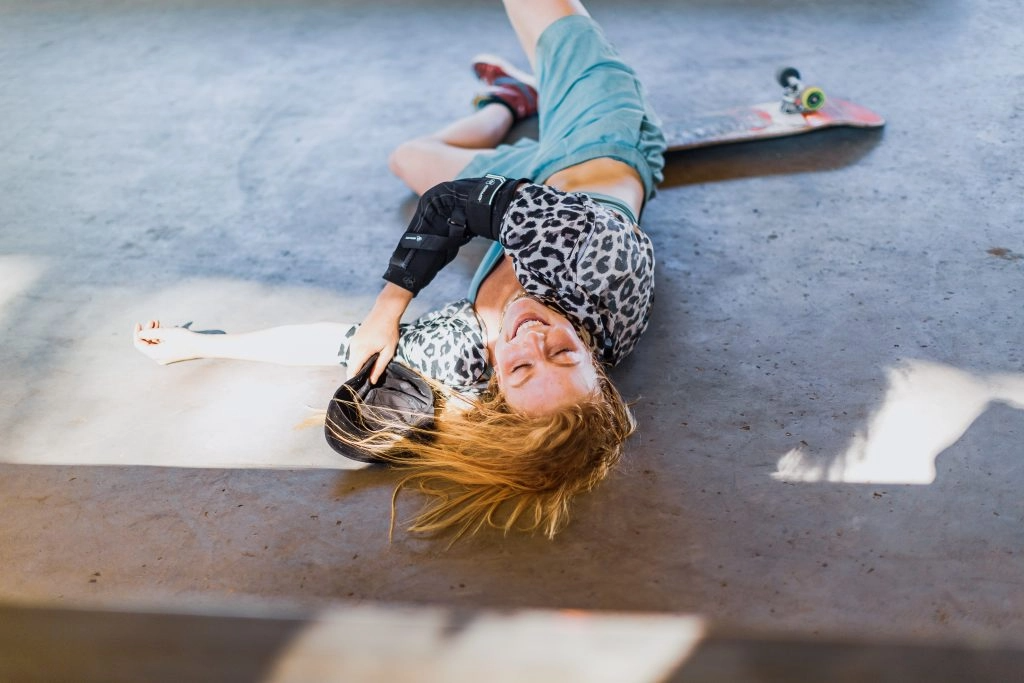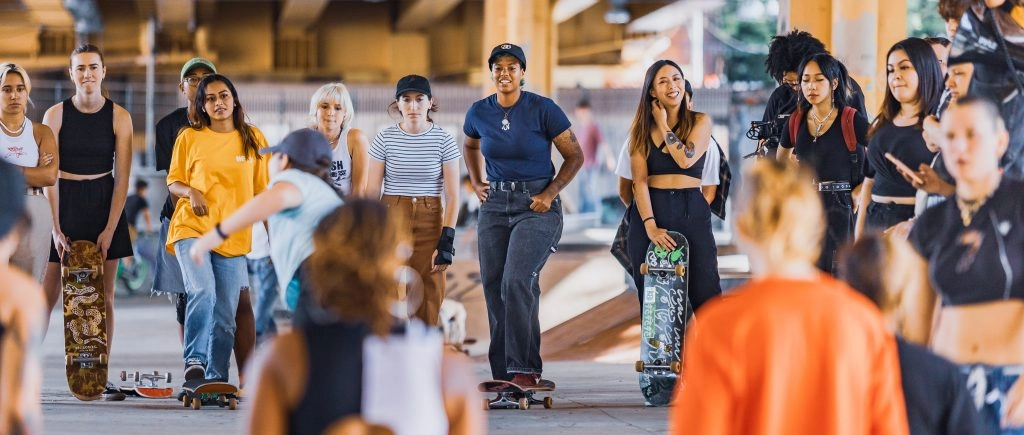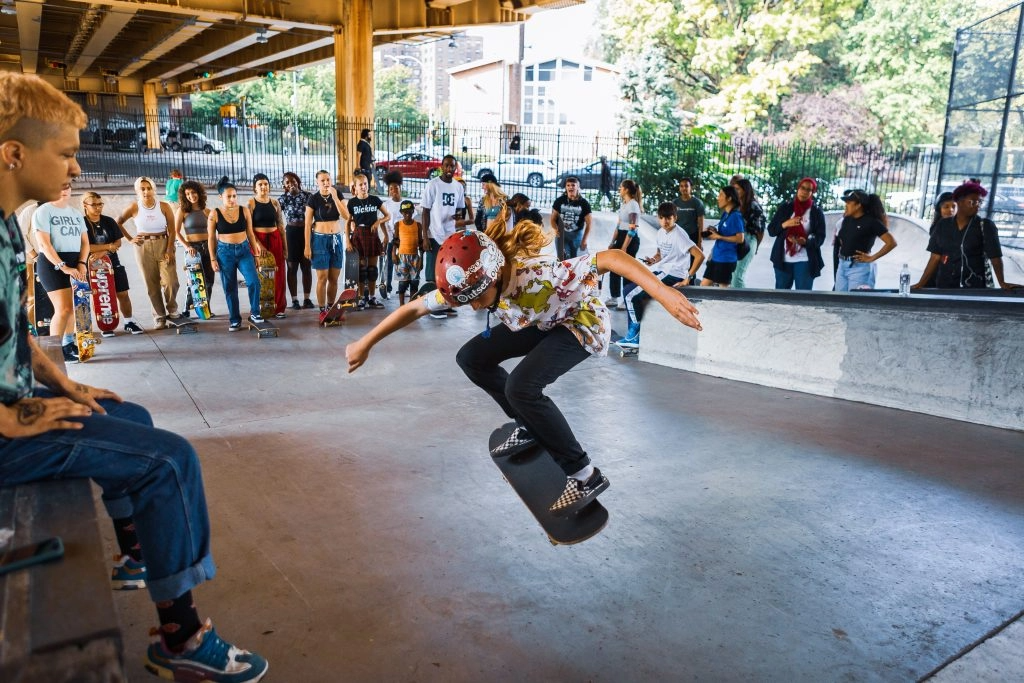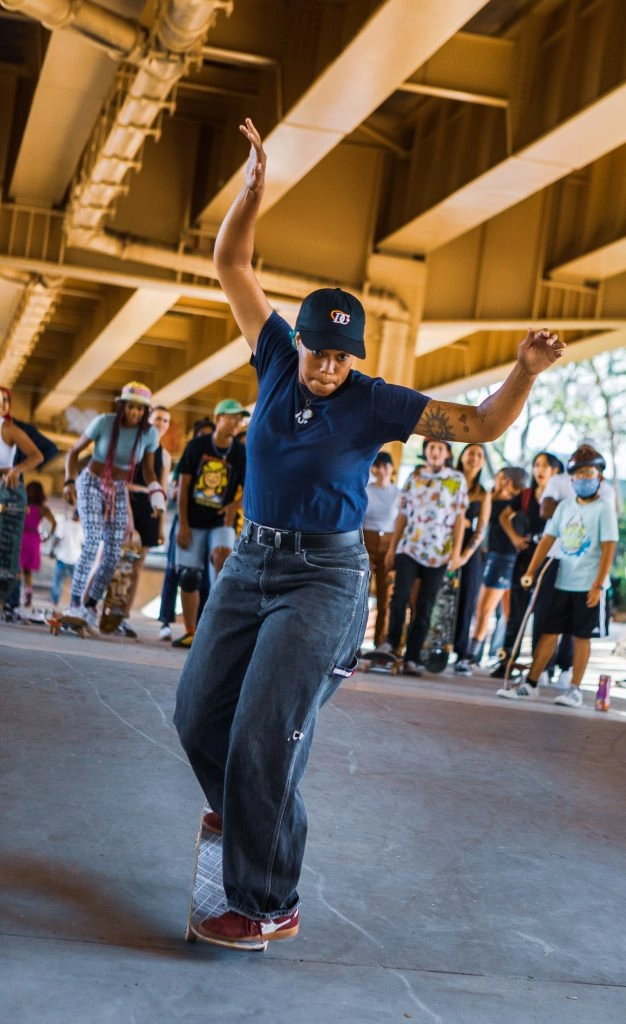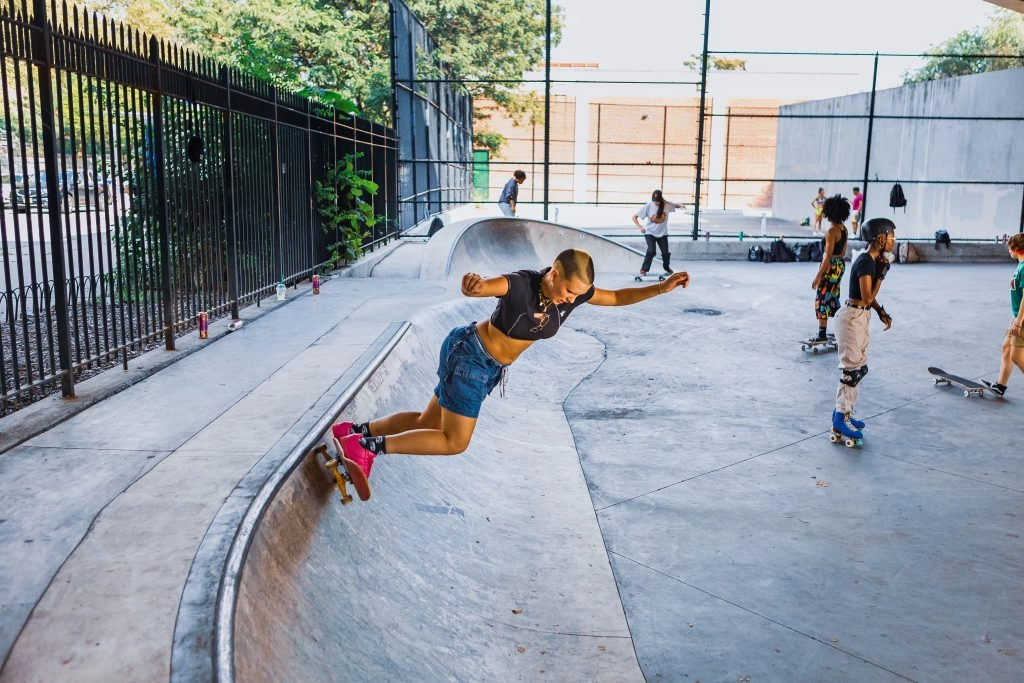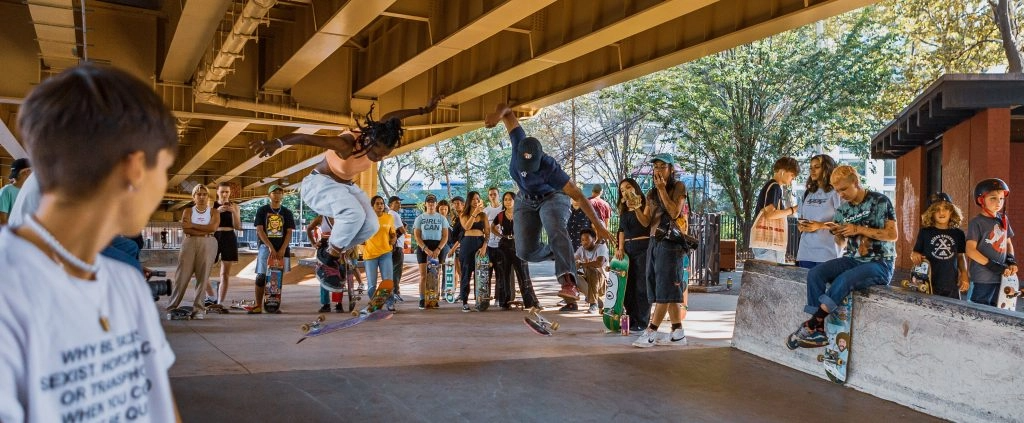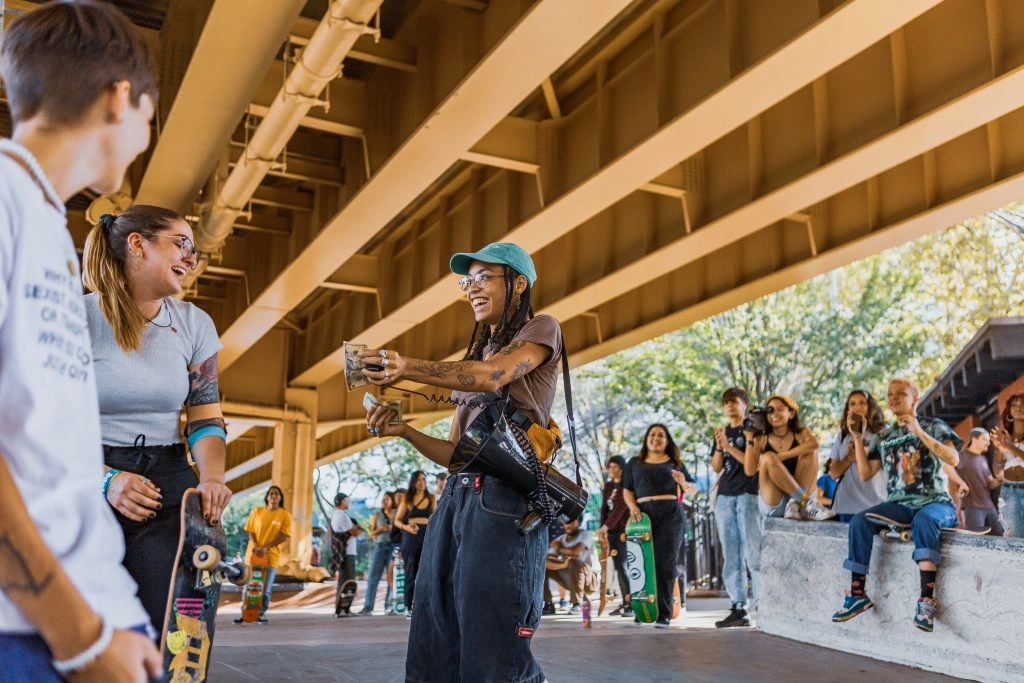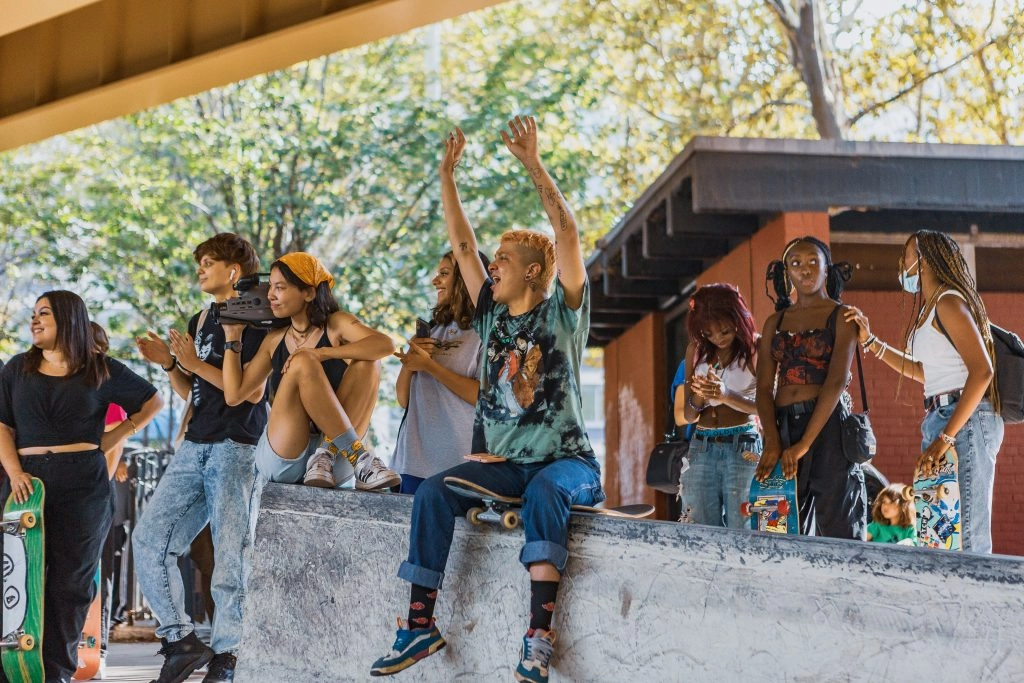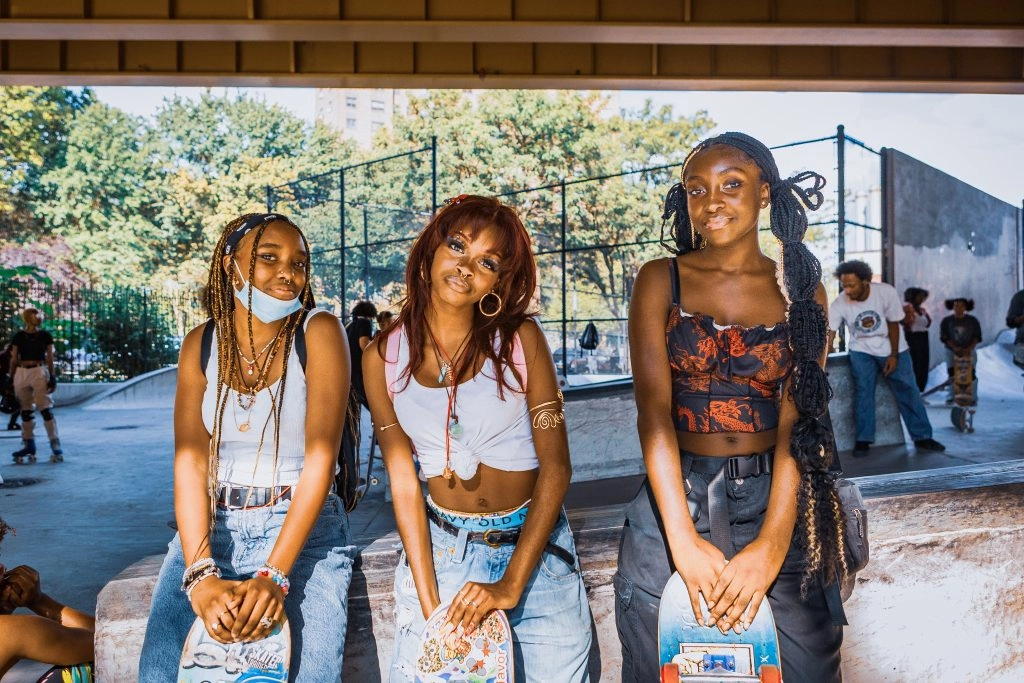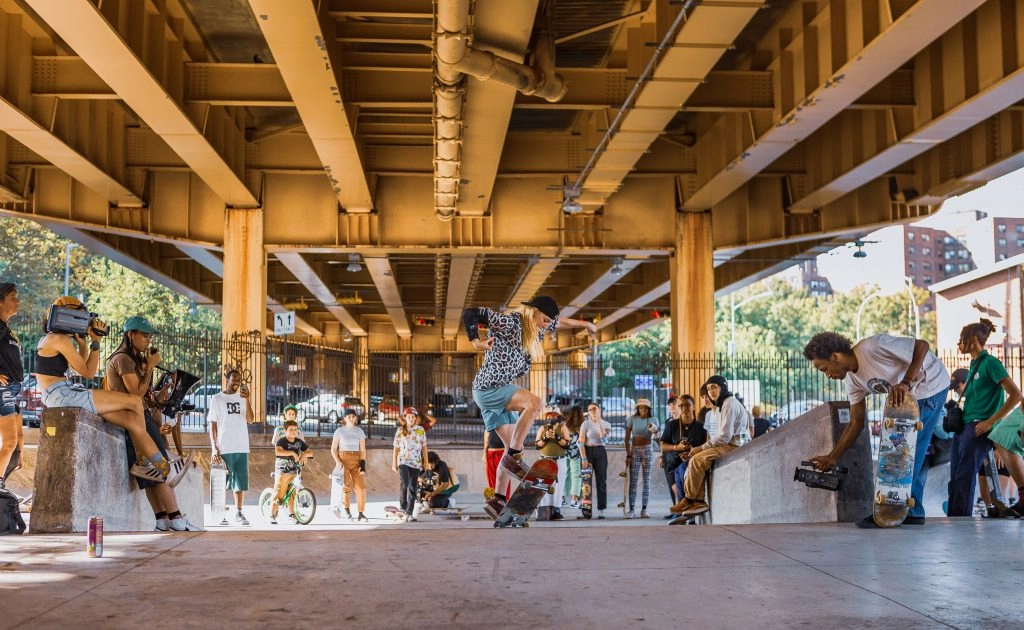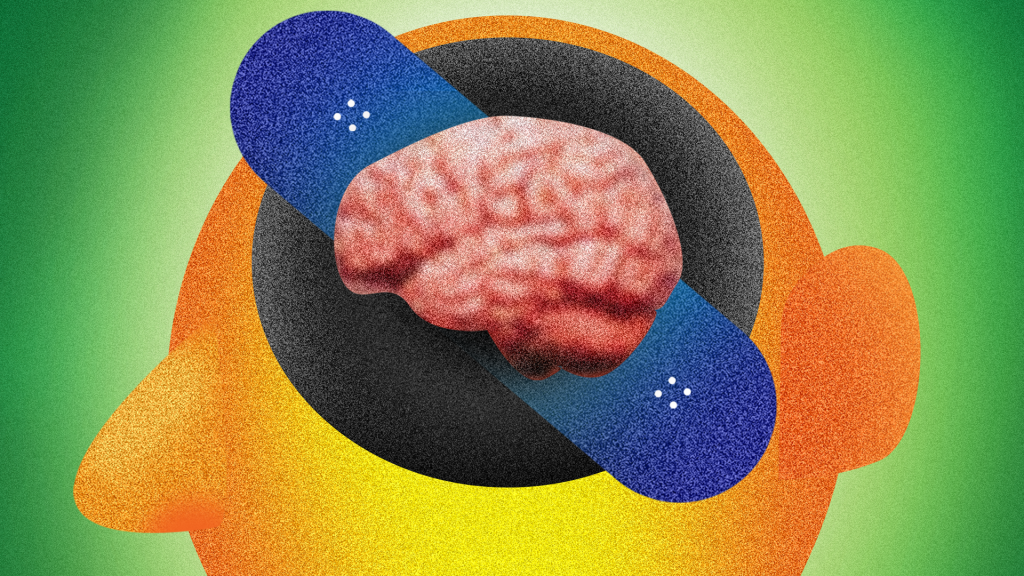On September 11, 2021 almost 100 non-traditional skaters came through to participate in an event hosted by Jae Leanne @e_ninethree, and The Harold Hunter Foundation at Fatkid Skatepark. As part of the Harold Hunter Weekend event, from noon to 5pm all skill levels came together to participate in the clinic, try some tricks for a chance to win cash, and product giveaways. We've always loved the community initiatives by HHF as well as Jae Leanne and what a way to celebrate Harold's legacy and NYC. See photos below
ARTICLE BY NATALIE HARPER
With all the recent conversation in skating around mental health— whether that be with Pushing Borders, Vent City, Quell Party, Skateism, or the ongoing work of the Ben Raemers Foundation— there is a potential now to introduce a new topic to the mix. So far the discussion has centered largely around anxiety, depression, and suicide prevention; however, I believe you cannot talk about mental health without talking about neurodiversity.
Neurodiversity is a term used to describe the natural variations that can exist in human brains. Someone can fit the label of neurodiverse if they are autistic, or have conditions such as dyslexia, ADHD, bipolar disorder, OCD, DID, as well as many others. However, it is entirely up to the person whether they choose to use this label or not.
As a disclaimer before we begin, this will not be comprehensive for all neurodivergent people, or even those who share my neurotype. What is to come was not created out of expertise, but out of necessity. Neurodivergent people are already very much a part of this community and yet there is little to no discussion of our existence, much less our needs, in skateboarding.
If there was more awareness of this and the lives of neurodivergent people then we as a community could spend less time managing symptoms and more time addressing possible causes and triggers.
I am an autistic trans woman with ADHD and OSDD 1a. I also have an anxiety disorder and experience depressive episodes. Oftentimes, as was the case for me, what may look like anxiety or depression at first is just a small piece of something more complex.
While changing a society will take time, the skate community can take a more active role in this change by making our spaces more welcoming for neurodivergent people.
SAY WHOSE TURN IT IS IN A RUN/LINEUP.
There is a great deal of nonverbal language that occurs at a skate spot. If someone is a newcomer, regardless of neurotype, they may not understand all the eye contact, head nods, and pointing that goes into figuring out who’s turn it is to skate an obstacle.
Many autistic people, myself included, have difficulty processing body language and facial cues, so the message you are trying to send with eye contact and a head nod might go right by us. Instead, try communicating verbally (and politely) whose turn it is.
PLEASE TURN DOWN THE MUSIC.
What may seem like a normal volume to neurotypical people can go from distracting to debilitating for autistic people and others with a sensitivity to sound. One solution to this would be, as has been done already at many movie theatres and restaurants, to set aside time when the music will be set (or capped) at a lower volume, or to simply turn it down the whole time.
“One thing I have done at skate events in the past is create a "quiet room," quiet being relative... but we set aside our back room for anyone who needs to step away from the bright lights and loud noises of the skatepark,” says AJ Waters, founder/owner of Stronger Skatepark.
“We set it up with some bean bag chairs, and bottles of water back there for anyone who needs them. Skateboarding is a very loud sport and it's really hard to minimize the sound, so having headphones and ear plugs available is a nice option as well.”
DO NOT STARE AT PEOPLE WHEN THEY STIM.
Short for self-stimulatory behavior, a stim is any repetitive movement used by an autistic person to either calm themselves down, build up focus or energy for a particular task, or express a strong emotion such as excitement or distress. This can include things flapping hands, rocking back and forth, leg bouncing, or hair twirling.
Many autistic people attempt to “mask,” or hide, their autsitic traits in order to blend in better with neurotypical society. I regularly limit my stims when I am out in public to what I feel will go unnoticed by most neurotypical people.
Masking can have an adverse effect on the person’s mental health, especially when it comes to stimming. Not doing so when we need to can lead to dysregulation and a build up of stress in the body. Autistic people need to know that in any space, whether that be at the store or the skatepark, we can stim without fear of getting odd looks from strangers in order to function at our best and truly be ourselves.
BE MINDFUL.
“I think the biggest thing I would want skaters to be aware of is the way they are taking up space. So many people at the skatepark skate super aggressively, and honestly most of the time skating that way is fine, but the way they stand on the deck, the way they jump at every opening to take a run, the way they yell when they are upset, etc... all these behaviors make the skatepark a super unwelcoming place to all sorts of people including neurodiverse people, who are more likely to experience anxiety,” AJ informs.
“So many skaters (especially men who have been skating a long time) just have no idea how their behavior, body language, skating style, etc. affect everyone around them.” AJ makes an excellent point that “by making skateparks more inclusive to beginners, queer people, women, etc, we are also making the skatepark more welcoming to neurodiverse folks.” Some of the work has already begun but these more established practices can be expanded slightly to help make skate spaces more welcoming for neurodivergent people.
BE INTENTIONAL WITH YOUR LANGUAGE
I often see posts for skate meetups that say something like “all abilities welcome.” However, for a long time this phrasing confused me. I couldn’t figure out if it means “all ability levels welcome,” as I have also seen it written, or if it is meant to imply that you are welcome whether you are able bodied or disabled.
If it is meant to also passively imply that disabled people are welcome, then why not instead take a more active approach and change it to something like “All Abilities and Disabilities Welcome”?
Of course, when inviting disabled people to an event or space, it is important that their accommodations be met. It is my hope that this article can be a small piece in that larger conversation that includes the work already being done in adaptive skateboarding and the wider disability rights movement within our community.
On the reverse side, be aware of harmful language being used by others. “There is also still a lot of homophobia and transphobia in the skate community, and there is a huge overlap between neurodiverse people and queer people.” says AJ, “So going to a skatepark and hearing gay used an insult can make many neurodiverse folks feel unsafe.”
NAME AND PRONOUN CIRCLES.
This small activity that is being used more frequently in skating can go a long way in helping a community that has long been stigmatized by society. People who have dissociative identity disorder (formally known as multiple personality disorder), OSDD 1a, or OSDD 1b may have one or two alters that enjoy skating.
It can help people with these disorders be their authentic selves and feel comfortable even entering a space if they are simply asked in the beginning their name and pronouns or the name and pronouns of someone else who may switch in later. It is completely understandable if someone doesn’t feel comfortable sharing that information, but if they do then the least we can do is use the right name and pronouns— just as we would for anyone else.
What I often hear is how important that sense of belonging is to so many in the skate community; How important it is to their mental health. In the previous piece I wrote with Quell, I spoke about feeling a small portion of this through watching other queer and trans skaters online, yet I feel a barrier between myself and other skaters I meet in real life due of a lack of understanding about neurodiversity in skating. For myself and countless others, neurodiversity and mental health do not exist in separation, but rather they compound one another. Exponentially.
What I am suggesting here is more than just some recommendations for some events. Many neurodivergent people don’t have anywhere else to go— don’t want to be anywhere else— and if skateboarding claims to be for all of those that society rejects, then I say prove it. Prove it to us that we belong here too.
We’ve mentioned this adage time and time again: When you see someone who looks like you, doing something you want to do it gives you that wave of acceptance to go for your goals. Black Girls Skate is more than an Instagram. They’re re-defining representation and access in the skate space. Whether it’s traditional skateboarding or ice skating, their feed is full of inspiration. We sat down with DJ Gooden and Nicole Humphrey to learn more.
What inspired you both to first start skating?
DJ Gooden: Rocketpower, I loved it when I was younger and I bugged my mom when I was eight to get me a skateboard. A landlord came over one day and came outside and taught me how to ride it like it was nothing. I wanted to be that cool since I saw that.
Nicole: I started cruising about five years ago and was introduced to an ex partner who was excited about it and bought me a skateboard. For the tour we did, I got an actual skateboard and picked up a couple months ago.
Aside from seeing the guy skate, how else did you start progressing? Were you watching videos or going to skateparks?
DJ: Okay so for childhood it was skating around riding for transportation. Recently, I moved to LA and when I lived out there I would get advice from others at the park. I was watching videos and noticing people had different equipment than I had. So then I started to get the right equipment for the skating I wanted to get into for riding bowls.
I wanted to create a place where we could celebrate ourselves
How did Black Girls Skate form?
DJ: Right before I left LA there was a really nice community out in LA who skated– not a lot of people who looked like me but still very friendly and inspirational. When I was looking up what I needed for bowls, I came across Samarria Brevard and was like wow why did it take me so long to stumble upon these professionals. So I started to question, ‘where is the equity in this?’ and I wanted to create a place where we could celebrate ourselves.
I started a social media where I could highlight all these Black and Brown skaters and then earlier I asked Nicole if she wanted to hop on the team. Nicole joined in and it’s snowballed from there.
That’s so awesome. So what are some of the things you guys do with the platform and in person?
DJ: We have Skaters Speak which is a 30 minute conversation where we have skaters to talk about some of the nuances they face in the skate world as well as some of the stuff that they bring to skate to have a positive experience. We also have our care box initiative which is an activation for certain skaters of different levels. It may be a token of appreciation or something they need.
How did the Skaters Speak panel get started?
Nicole: It started three or four months ago. The idea was to build the audience around the platform we have. We were beginning to organize with our seventeen ambassadors and thought it would be cool to create a dialogue between them and some of the other folks that follow our account. What put the fire to it was getting a Reebok representative to activate a campaign around us all about legacy and we were able to use that platform to provide a budget to get guests on and have a conversation. Once our ambassadors got excited about it, we started to plan how often to do it.
With the tour, we’re back to once a month but it lives on IG live as a 30 minute conversation series. We want to grow it into its own series in physical form in a panel with skaters all around the world.
Being able to hear from your ambassadors and speak in your own words is such a powerful step that is missing when you’re just reading an Instagram caption or something like that. How do you pick ambassadors? What does that look like?
Nicole: We launched our ambassadors through an open call on our social media platform. We didn’t know initially what we would do but we wanted to add to our service. Our goal was to pick fifteen and we got over fourty applications. We settled on seventeen out of all the applicants. The ideas were content based but when we started to connect monthly, things started to get really heavy around the world. So we just started to have check-ins and see how everyone was doing and feeling. Some folks were skating, some weren’t. Specifically because we didn’t know how safe everything was. We have an ambassador in the UK, France, all around the world. The goal is to have them to continue our programming.
That’s so cool, I can totally empathize with not understanding where to go next in this environment. I think there are a lot of eyes right now on the Black and Brown community of skating so it’s really cool to have so many perspectives through your platform. What kind of things are in your ambassador boxes? How did you create that idea?
Nicole: DJ wanted to do a meetup for our one year anniversary. Of course with the pandemic we thought more about what we could do now since we couldn’t come together. We thought a lot about the virtual events and we started to think about the educational component: How could we send you gear and have an online event where we teach you how to assemble it? Long story short, that was too much to manage and make it fair to distribute.
The world started to open back up this Summer a little and with that, we felt comfortable to define our own safe social distance practice to distribute these boxes. We didn’t feel like a meetup was safe but we wanted to figure out where to pass these out. Additionally, every supplier was so backed up and it was really difficult to figure out what to offer up. So we thought about PPE and other types of accessories that go with skateboarding.
We really wanted to focus on a wearable, something to inspire you to skate, a Thrasher magazine “Black Skaters Issue”, a face mask. It was a combination of things but it was an idea to create a continuous care box program. We could ship out these accessories and hardware or equipment.
I think that’s such a great idea. The whole root is accessibility and to your point, it’s more difficult to send it out. I’d love to see how that progresses. Specifically this time it was in a tour setting. What was the inception of that?
Nicole: So basically once we decided that we could have a safe way to give stuff away, we started to arrange pop-up events to create a moment in these cities. We were able to drive and use our ambassador crew in various cities to partner with a shop or community group and then name a skate park to take over for some hours. So quickly in New York for example, we did our event at KCDC and they also donated things and let us use their space. We made it collaborative but we had a goal of 100 boxes to give out.
So aside from NY where did you go?
DJ: Atlanta, New York, Philly, Dayton, Chicago
Obviously you picked them surrounding your ambassadors, was that mainly because you were driving or how did those cities stand out?
DJ: I live in Atlanta and Nicole lives in Chicago so those were easy. Then the other cities we had a big ambassador presence. We also did an event with Proper Gnar in Ohio.
What are some of the things you guys are working on for the future?
Nicole: We’re digging in internally. We were able to reflect from the tour on our strengths and areas of opportunities. For the next 4-6 months we’re going to update our roles and our budgets. We can set ourselves up for annual success. We are in the process of the software and hardware side of development. We want to launch products and merch.
We’re also re-defining our ambassador program to bring new ones on. We want to be able to duplicate our programming all around the world.
That’s so important and the fact you can define that is really powerful. When you build that foundation you can action it and it’ll build from there. The boxes are so unique, especially in the women's space as well.
How can people not necessarily in the skate community get involved or support BGS?
DJ: Comments, likes, shares, reviews are so helpful. Financial contributions and networking help. Reaching into our DM’s are ways to reach out and support us whether you're a skater or not. Our needs, wants and goals are evolving so we’re in the process of defining what that looks like too.
We wanted to share all skate styles, not just skateboarding as well. A skateboarder could pick up rollerblades, you never know what is inspirational to them.
There are so many different accounts that are coming to terms with the fact they’re not diverse. You’re obviously doing this from a place that is not performative but impactful or uplifting. What do you look to post on Instagram?
DJ: I look for anything that amplifies someone or is inspirational.
Nicole: We wanted to share all skate styles, not just skateboarding as well. A skateboarder could pick up rollerblades, you never know what is inspirational to them.
I really liked that it’s the definition of skate. Obviously our content surrounds skateboarding but the breadth of everything you post is so cool. How does that translate to the boxes you produce?
DJ: That was some of the obstacles we initially ran into with the sizes of wheels because some wheels go towards certain skaters. As we define our program we can better organize which box goes to which skater.
Why do you feel like it’s important that groups or pages like BGS exist?
DJ: For me, I felt a need for a place to amplify and celebrate ourselves and our accomplishments. A lot of times minority groups go unnoticed. I think it’s very important to let our peers and people outside our communities know these things are happening. I want the younger generation to see that and see people who look like them are doing this and they could do it too and even greater.
Zorah Olivia is probably responsible for your favorite skate photos.
She’s a tour de force in the skate industry, covering everything from: the X Games to the upcoming Olympics and goofy portraits of our skate icons. Zorah’s crystal clear style stops each moment so perfectly. This photo series from the 2019 Dew Tour offers a snapshot of what Zorah captures best. We sat down to talk the contest, Zorah’s life, and everything skate photography.
Photos by Zorah Olivia. A version of this interview appears in Issue 004 of Quell Skateboarding. Buy a copy online here.
Can you give us a brief history of how you started skating and shooting?
I started skating when I was 10 years old. I remember watching my cousins play Tony Hawk’s Pro Skater and I was hooked. I’ve honestly always been shooting photos. Both of my parents are photographers, so I grew up in an artistic household. Naturally at first as a kid, you want to do the exact opposite of what your parents do, so skateboarding was my main focus for years. It wasn’t until I turned 16 that I really started taking photography seriously.
How do you think going to Woodward for skating and for photography has influenced your approach to skateboarding and capturing skateboarding?
Going to Woodward as a kid absolutely shaped who I am as an individual, skateboarder and a photographer. Woodward was the first time that I was exposed to other female skaters. I felt free and able to fully be myself. When they introduced the photography program to camp in 2009 my entire world changed. For the first time, I was given access to top professional skateboarders, the best photography equipment, and real life photo scenarios. To this day, I’m still incredibly grateful for that time in my life.
Often skate photography is just about the ‘spot’ as it is about the subject or the trick - can you talk a bit about how you approach skate spots and angles?
The majority of the time, skaters and filmers introduce me to spots, so when I go out with them I’m seeing everything for the first time. You can make a creative image out of any spot, it’s all about using your eye to pull the best qualities out of any location. The key is to pay attention to the details, colors, textures, and human elements.
What’s your ideal setting for taking skate photos?
A spontaneous phone call from a friend, meeting up for iced coffee first, and exploring the city for unusual spots. It’s all about being spontaneous for me and my crew.
Do you approach street, park and contest photos differently?
Street definitely comes naturally for me, park and contest shooting is always a necessary learning experience. I just observe first and pre-visualize how I want to shoot the skaters desired trick. Contest photography is more so about getting as much content as you can in a set amount of time.
How did you get involved in shooting contest photography?
Contest photography was actually my first true introduction to the skate industry! In 2016, I emailed Kim Woozy from Mafia.TV and asked about internships. She emailed me back and really liked my portfolio. We ended up talking on the phone for over an hour. On that same first phone call, Kim invited me to shoot the X-Games in Austin, Texas! She flew me out to Seattle, WA first to introduce me to the female skate community. That was my first time at Wheels of Fortune, so officially WOF was the first time I shot a skate contest.
Specifically, what were some of the exciting parts and some of the challenges of shooting this year’s Dew Tour?
My only challenge with Dew Tour was gaining access to the course to shoot with the girls. But I did end up meeting a lot of amazing people who helped organize Dew Tour that want me to officially shoot for them next year! The most exciting part about Dew was seeing all of my friends in one place. That’s what we all love about contests, no matter how much pressure we all feel, we’re just thankful to be with each other. It’s like a big family reunion.
How did you approach photographing practice versus the contest?
During practice, I always try to get as much action content as possible because on finals day they absolutely won’t let you anywhere near the course. Finals day I focus on the individual skaters, their reactions with not only themselves but with everyone else. I just want those viewing my photos to feel how they felt that day.
If we came back from the future to tell 14 year old Zorah that when you get older you’ll be shooting some of the biggest pro skaters in the world, how would you react?
I probably wouldn’t believe you! But that would have saved me years of worrying about my future.
We heard, from you, that you’ll be shooting at the Olympics, would you like to share a little about how you got the opportunity and how you’re preparing for it?
Yes! I recently signed with FujiFilm. I’m incredibly grateful for their support. I’m currently working on the early stages of a photo series leading up to the Olympics. More details coming soon!
What’s your advice for people who want to get into skate photography?
Practice, be vulnerable and fully put your heart into your work.
When the rad dudes at Freedom Skatepark reached out to us about hosting a Women + Queer skate sessions called Mercury 13 we knew we couldn’t pass up the opportunity. It was awesome to come back to help this year and skate the new obstacles repurposed from House of Vans in Philadelphia, built by 5th Pocket. The park is so welcoming and had something for every level. Clif Bar provided the yummy snacks, and we had lots of raffle prizes to give out from: Krux Trucks, Independent, Bronson Berrings and Creature. Check it out this winter and keep an eye out on Freedom's Instagram for more events.
See our photos from Mercury 13 below
Thanks so much to our sponsors for this killer raffle: Krux, Independant, Bronson and Creature.



